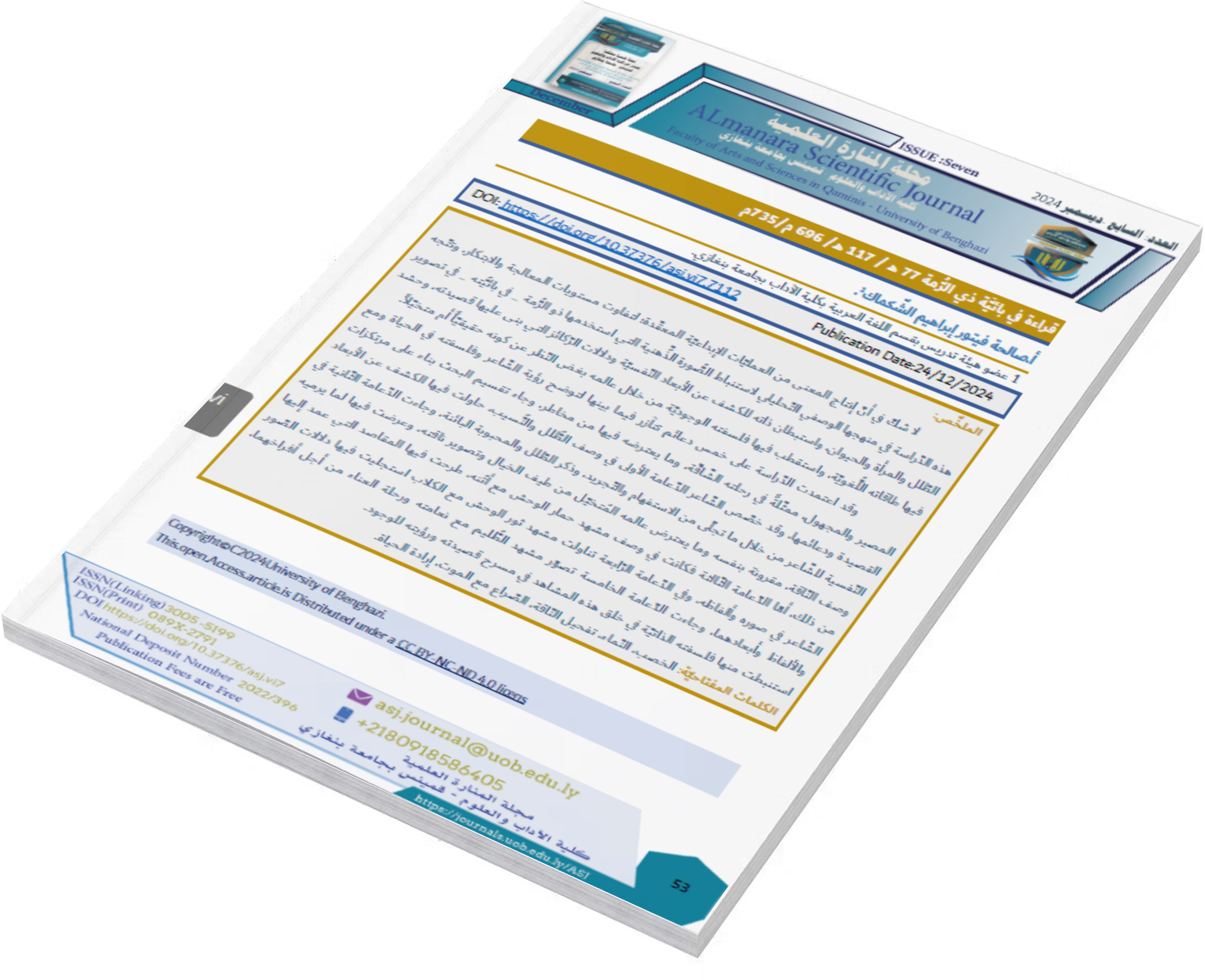قراءة في بائيَّة ذي الرُّمة 77 هـ / 117 هـ/ 696 م/735م
DOI:
https://doi.org/10.37376/asj.vi7.7112Keywords:
fertility, growth, camel mating, struggle with death, will of LifeAbstract
Levels of processing and innovation. There is no doubt that the production of meaning is one of the complex creative processes; due to its variation, and this study tends in its descriptive and analytical approach to infer the mental image that Dhu al-Rummah used in his poem in depicting the ruins, the woman and the animal, and to introspect himself to reveal the psychological dimensions and connotations of the pillars on which his poem was built, and in which he mobilized his linguistic energies and attracted his existential philosophy through his world regardless of whether it was real or imaginary.
The study relied on five pillars that support each other to clarify the poet’s vision and philosophy in life, destiny and the unknown represented in his arduous journey and the dangers he faces in it. The research was divided based on the foundations and pillars of the poem. The poet devoted the first pillar to describing the ruins and the kinship, in which he tried to reveal the psychological dimensions of the poet through what was revealed from the question and abstraction, and the mention of the ruins and the distant beloved.
The second pillar came in describing the camel coupled with himself and what his imaginary world encounters from the specter of imagination and the depiction of his camel, and in it I presented what he aims for from that. As for the third pillar, it was in describing the scene of the wild donkey with its two young, in which I presented the purposes that the poet intended in his images and words. In the fourth pillar, I dealt with the scene of the wild bull with the dogs, in which I clarified the meanings of the images and words and their dimensions. The fifth pillar came to depict the scene of the gazelle with its ostrich and the journey of suffering for their chicks, from which I derived his personal philosophy in creating These scenes are in the theatre of his poem and his vision of existence.
Downloads
References
- القرآن الكريم.
- أبو بكر أحمد بن محمد الصّنوبري، شرح بــــــائية ذي الرُّمة، تح: محمود مصطفى حــــــــــلاوي، مؤسّسة الرّسالة، ط1، 1985.
- أبو زكريّا يحيى بن علي بن محمد الشّيباني الخطيب التّبريزي، ديوان ذي الرّمة شرح الخطيب التّبريزي، كتب مقدمته وهوامشه وفهارسه: مجيد طراد، دار الكتاب العربي، ط2، 1996.
- أبو زيد محمّد بن أبي الخطّــــاب القُرشــــي، جمهرة أشعــــــار العرب، المطبعة الرّحمـــــــانيّة، مصر، د. ط، د.ت.
- أبو عبد اللّه محمّد بن سلام الجمحي، طبقات فحول الشّعراء، دار الكتب، العلميّة، بيروت، د. ط، د.ت.
- أبو عبد اللّه محمّد بن عمران بن موسى المرزباني، الموشح في مآخذ العلماء على الشّعراء، تح: محمد حسين شمس الدّين، دار الكتب العلميّة، بيروت، ط1، 1995.
- أبو علي الحسن بن رشيق القيرواني، العمدة في محاسن الشّعر وآدابه ونقده، تح: محمد محي الدين عبد الحميد، دار الجيل، بيروت، ط 5، 1981، ج1.
- أبو الفرج علي بن الحسين الأصفهاني، الأغاني، شرحه وكتب هوامشه: عَبد أ. علي مهنّا، دار الكتب العلمية، بيروت، ط4، 2002، ج18.
- أبو محمد عبد الله بن مسلم بن قتيبة الدّينوري، الشِّعر والشّعراء، تح: أحمد محمّد شــــــــــــاكر، دار المعارف، د. ط، 1985،ج1.
- أبو نصر أحمد بن حاتم الباهلي، شرح ديوان ذي الرُّمة، رواية الإمام أبي العبّاس ثعلب، تح: عبد القدوس أبو صالح، مؤسسة الإيمان، جدة، 1982، ج1.
- غيلان بن عقبة العدوي، ذو الرّمّة، ديوانه، تح: كارليل هنري هيس مكـــارتني، طُبع على نفقة كلية كَمْبريج في مطبعة الكلية، د. ط، 1919.
-ـــــــــــــــــــــــــــــــــــــــــــــــ، ديوان ذي الرُّمة، تح: عمر فاروق الطّباع، شركة الأرقم بن أبي الأرقم، بيروت، ط1، 1998.
ثانياً-المراجع:
- خير الدّين الزّركلي، الأعلام، دار العلم للملايين، بيروت، ط15، 2002..
- زكريّا عبد المجيد النّوتي، ثور الوحش بين النّـــــَابغة الذبياني وذي الرُّمة، إيتــــــــــــــراك للطبـاعة والنَّشر والتَّوزيع، ط1، 2004.
- شوقي ضيف، التّطور والتّجديد في الشّعر الأموي، دار المعارف، القاهرة، ط 10، 1959.
- عبد القادر القط، في الشّعر الإسلامي والأموي، دار النّهضة العربية للطّباعة والنّشر، بيروت، د. ط. د.ت.
- علي البطل، الصُّورة في الشّعر العربي حتى آخر القرن الثّاني الهجري، دراسة في أصولها وتطوّرها، دار الأندلس، ط1، 1980.
- عمر بن عبد العزيز السيف، بنية الرّحلة في القصيدة الجاهليّة، الأسطورة والرّمز، الانتشــــــار العربي، بيروت، ط1، 2009.
- كيلاني حسن سند، ذو الرّمة شاعر الحبّ والصّحراء، د. ط، 1970.
ثالثاً- البحوث العلميَّة:
-عمر محمّد طالب، بحث بعنوان: صراع الحياة والموت في شعر امـــــــرئ القيس، مجلّة آداب الرّافدين، تصدر عن كليّة الآداب، جامعة الموصل، العدد التّاسع، أيلول/ سبتمبر، 1978.
رابعاً-رسائل الدُّكتوراه:
-محمد حسن الزّير، رسالة دكتوراه غير منشورة بعنوان: فكرة الحياة والموت في الشِّعر الأُموي، جامعة القاهرة، كلية الآداب، قسم اللُّغة العربية وآدابها، 1982.

Downloads
Published
How to Cite
Issue
Section
License
Copyright (c) 2024 Almanara Scientific Journal

This work is licensed under a Creative Commons Attribution-NonCommercial-NoDerivatives 4.0 International License.







